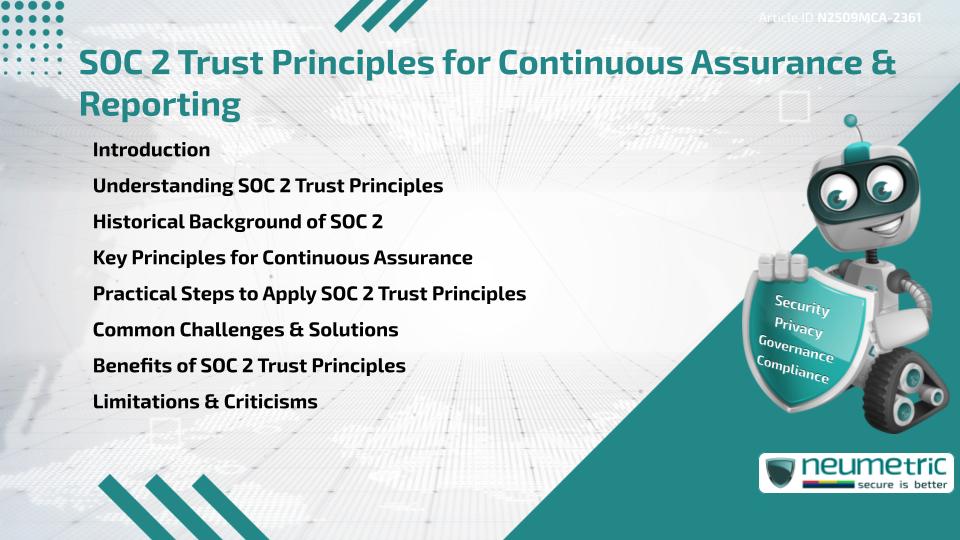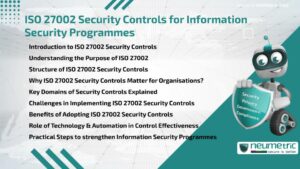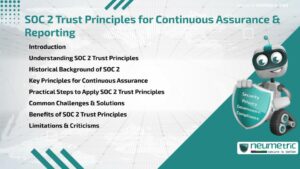Table of Contents
ToggleIntroduction
SOC 2 Trust Principles provide the foundation for continuous assurance & reporting in Organisations that handle Sensitive Data. These principles focus on ensuring Security, Availability, Processing Integrity, Confidentiality & Privacy. By following SOC 2 Trust Principles, businesses enhance Trust with Stakeholders, reduce Risks & meet Compliance expectations. This article explores the origins, principles, practical steps, challenges, benefits & criticisms of SOC 2 Trust Principles.
Understanding SOC 2 Trust Principles
SOC 2, developed by the American Institute of Certified Public Accountants [AICPA], defines Trust Services Criteria to evaluate an organisation’s systems. The SOC 2 Trust Principles help ensure that systems & processes maintain robust Controls over data handling & reporting. These principles apply to service providers managing Client information & form a key part of Third Party assurance.
Historical Background of SOC 2
SOC 2 evolved from earlier Auditing standards & reports, such as SAS 70. Introduced in 2011, SOC 2 was designed to provide a standardised method of evaluating service Organisations. Over the years, updates have refined the Trust Services Criteria, aligning them with emerging Risks & Global Standards for Security & Privacy.
Key Principles for Continuous Assurance
SOC 2 Trust Principles are based on five categories:
- Security: Protecting Systems & Data from unauthorised access
- Availability: Ensuring systems are operational & accessible as needed
- Processing Integrity: Confirming data is complete, valid & accurate
- Confidentiality: Safeguarding Sensitive Information from unauthorised disclosure
- Privacy: Protecting Personal Information in Compliance with Policies & Regulations
These principles form the backbone of continuous assurance & help Organisations maintain Transparency.
Practical Steps to Apply SOC 2 Trust Principles
Organisations can adopt SOC 2 Trust Principles through:
- Identifying applicable principles for their services
- Designing & implementing Controls to meet criteria
- Conducting internal Risk Assessments
- Monitoring Controls for effectiveness
- Undergoing independent SOC 2 Audits to validate Compliance
Documenting processes & aligning them with organisational goals ensures continuous Reporting & Trust.
Common Challenges & Solutions
Challenges include the complexity of implementing Controls, the cost of Audits & the need for Continuous Monitoring. Small Organisations may struggle with resource limitations. Solutions include phased implementation, leveraging automation tools & seeking expert guidance to streamline Compliance.
Benefits of SOC 2 Trust Principles
Benefits of adopting SOC 2 Trust Principles include:
- Strengthened Stakeholder Trust
- Competitive advantage in regulated industries
- Enhanced Risk Management
- Demonstrated Compliance with Security & Privacy standards
- Improved internal Processes & Accountability
Limitations & Criticisms
SOC 2 Trust Principles can be resource-intensive, especially for smaller Organisations. Critics argue that Audits may become more of a Compliance exercise than a true measure of effectiveness. Additionally, Audits are time-bound, which may not always reflect ongoing Risks. Balancing Compliance with practical security practices is essential.
Conclusion
SOC 2 Trust Principles provide a robust Framework for continuous assurance & reporting. While challenges exist, the benefits of adopting these principles far outweigh the drawbacks, especially in building Trust & meeting Compliance demands.
Takeaways
- SOC 2 Trust Principles include Security, Availability, Processing Integrity, Confidentiality & Privacy.
- They provide a foundation for continuous assurance & reporting.
- Practical steps involve implementing Controls, Monitoring & independent Audits.
- Challenges include complexity & costs, but these can be managed through phased approaches.
- Compliance improves Trust, Competitiveness & Risk Management.
FAQ
What are SOC 2 Trust Principles?
They are criteria that assess an organisation’s systems in terms of Security, Availability, Processing Integrity, Confidentiality & Privacy.
Why are SOC 2 Trust Principles important?
They ensure continuous assurance & demonstrate a company’s commitment to Secure & Reliable practices.
Who needs SOC 2 Trust Principles?
Service providers that manage or process Customer Data benefit most, particularly in Technology & Cloud Services.
How are SOC 2 Trust Principles applied?
Organisations apply them by implementing relevant Controls, monitoring them & undergoing independent Audits.
What challenges exist with SOC 2 Trust Principles?
Challenges include Resource requirements, ongoing Monitoring needs & high Audit costs.
Is SOC 2 Certification the same as SOC 2 Trust Principles Compliance?
SOC 2 Certification confirms an organisation’s controls align with the Trust Principles, verified by an independent Audit.
How often should SOC 2 audits be performed?
Audits are typically conducted annually, though some Organisations choose Continuous Monitoring for greater assurance.
Are SOC 2 Trust Principles mandatory?
They are not legally mandatory but are widely required in contracts, especially with clients in regulated industries.
Need help for Security, Privacy, Governance & VAPT?
Neumetric provides organisations the necessary help to achieve their Cybersecurity, Compliance, Governance, Privacy, Certifications & Pentesting needs.
Organisations & Businesses, specifically those which provide SaaS & AI Solutions in the Fintech, BFSI & other regulated sectors, usually need a Cybersecurity Partner for meeting & maintaining the ongoing Security & Privacy needs & requirements of their Enterprise Clients & Privacy conscious Customers.
SOC 2, ISO 27001, ISO 42001, NIST, HIPAA, HECVAT, EU GDPR are some of the Frameworks that are served by Fusion – a SaaS, multimodular, multitenant, centralised, automated, Cybersecurity & Compliance Management system.
Neumetric also provides Expert Services for technical security which covers VAPT for Web Applications, APIs, iOS & Android Mobile Apps, Security Testing for AWS & other Cloud Environments & Cloud Infrastructure & other similar scopes.
Reach out to us by Email or filling out the Contact Form…





